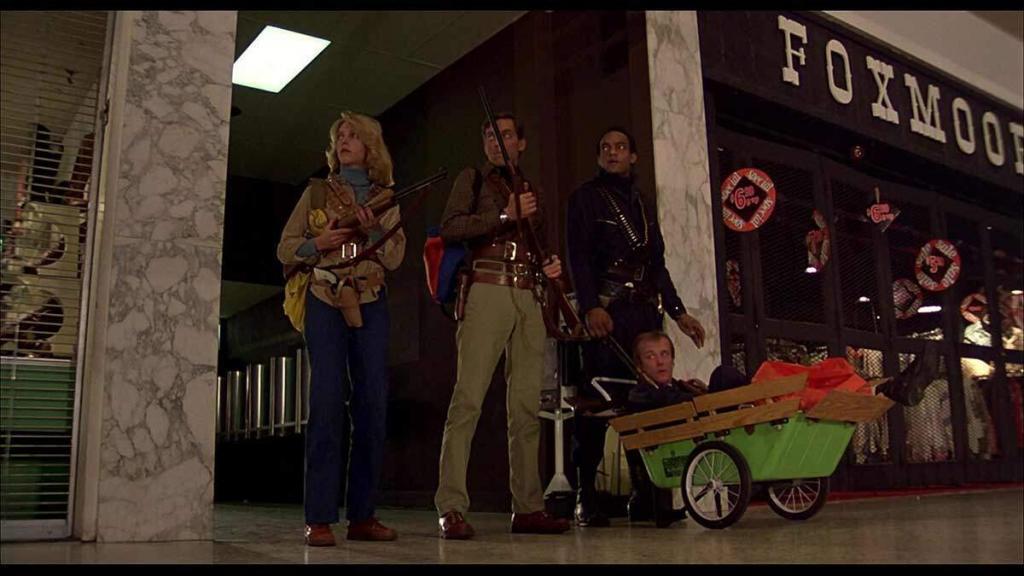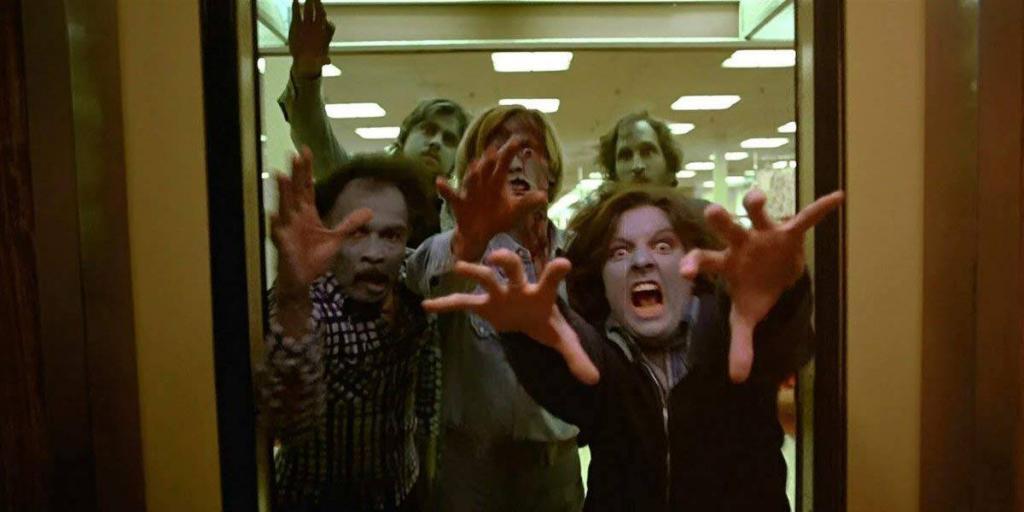In modern usage, the word decadence is usually associated with luxury. A fancy dessert may be decadent, as may a gown encrusted with diamonds. More specifically, though, the term denotes a period of moral decline and extravagance prior to the collapse of a once-great civilization. Think of the orgies of the late Roman Empire, or the glamorous parties of the Roaring 20s. It also shares its root with another, less attractive word: decay. A society entering its decadent phase is one that has already died, and indeed has begun to rot. Party-goers and merry-makers may attempt to distract themselves from this, but eventually the stench will become unbearable. So hows does that relate to Dawn of the Dead 1978?
1978’s Dawn of the Dead is a movie about decadence in every sense of the word. Faced with the threat of human extinction, the film’s heroes barricade themselves inside a shopping mall, living out a consumerist utopia while zombies run rampant outside. The more they lose themselves in material pleasures and hedonism, the more obvious it becomes that the world as they know it has ended. This horror classic from George Romero is a scathing indictment of a civilization in decline, a chronicle of American decadence in all of its glitz, glamor, and gore.

Initially, the social commentary in Dawn of the Dead may seem a touch on-the-nose. Watching zombies stagger around the mall, the characters comment how their behavior is not so different from before. They return to the mall due to “some kind of instinct,” says Stephen (David Emge), “a memory of what they used to do.” Horrified by the almost-human behavior of the shopping dead, Francine (Gaylen Ross) asks: “What are they?” Peter (Ken Foree) responds: “They’re us, that’s all.” There is little difference, Romero implies, between the mindless consumerism of 1970s America and the shambling of an undead horde.
Direct equivalence between mall-goers and zombies, though, is a more simplistic reading than Dawn of the Dead deserves. A richer meaning can be found by moving beyond simple metaphors and thoughtfully examining the dynamics between human beings and their environment. What this cinematic “dissection” reveals is a recurrent motif of decadence. Throughout the film, there is a consistent mismatch between living, flourishing tissue on the outside, and stagnation and decay beneath the surface. The characters who are unwilling to recognize the ugliness beneath a thin veneer of decadence are doomed; the only hope for survival is to stop living in denial and face the grim, unavoidable truth.
Dawn of the Dead 1978 Original Trailer
This mismatch is present from the very beginning of the film, and harkens back to Romero’s original Night of the Living Dead. In Night, the news was a source of security — TV anchors gave advice to survivors throughout the film, even directing them to evacuation sites. In the first moments of Dawn, however, we are taken behind the scenes at a news station where it is clear that nobody knows what they are doing. The studio is in chaos, with half of the staff yelling over one another, and the other half abandoning their posts. Even the list of evacuation sites from Night is revealed to be out-of-date — although this last detail does not stop an executive from insisting that the studio continue to broadcast the list. What’s sending a few survivors to their deaths, after all, as long as viewership remains high?
Right after this introduction comes another crucial sequence, in which a unit of the National Guard invades a public housing complex whose tenants have refused to give up their dead. By clinging to old rituals and refusing to accept their new reality, these tenement-dwellers have locked themselves in with a horde of zombies. More depraved, though, is the behavior of the National Guard toward these (mostly black and latinx) civilians; they fire machine guns indiscriminately, causing more deaths than the zombies themselves. Hidden beneath a thin layer of government-sanctioned authority, the moral decay of these unhinged, bigoted soldiers is apparent. Once again a curtain is whipped aside, revealing the ugly truth of a society hopelessly in decline.
These two introductory sequences expose how central institutions of modern America — media and law enforcement — are thin bandages over seeping wounds. The rest of the film, set almost entirely in the shopping mall, doubles down on this theme. Even after our heroes establish a secure base camp with enough supplies to last a lifetime, there is little comfort to be found. The novelty of an unlimited shopping spree wears off quickly, and it is soon clear that they are merely going through the motions of decadence. The more they distract themselves with lavish outfits and expensive toys, the more their consumerist paradise resembles a slaughterhouse.

Eventually the contradictions between outer decadence and internal decay become impossible to reconcile. After one of the four is killed securing the perimeter of the mall, the others decide they would rather face an uncertain future than die inside a prison of their own making. This about-face comes too late, though, as their attempts to flee attract the attention of a roving gang of bikers. The sinister delight with which the bikers descend on the mall may seem a bit over the top, but that is the point. Other than their lack of restraint, there is no substantial difference between these cackling Mad Max rejects and our own heroes. If the world as they know it has died, then what is really more depraved: basking in decadence, or stripping it for parts?
As the ending credits play over a cheerful montage of zombies romping through the mall, the film’s message stays with the viewer like a bad taste.
If Night of the Living Dead showed America as a powder keg ready to burst, then 1978’s Dawn of the Dead makes the claim that it has been dead for years already; we are simply living our last, decadent years inside its rotting corpse. What better way to illustrate this than to juxtapose the literal walking dead next to the rituals of modern consumerism? George Romero proved with his followup to Night that he could go bigger, bloodier, and more ambitious. But more than forty years later, it is the powerful social message of this horror classic that stands out the most.

Joseph Green is a writer, filmmaker, and lifelong horror nut. When he isn’t watching horror movies or listening to heavy metal music, he is writing articles about them.
